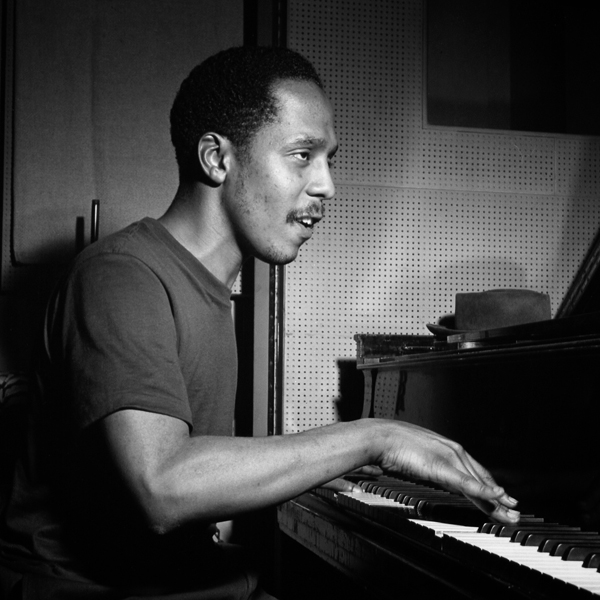June 20, 2013
To go along with the “amazing” word of wonder, add dazzling, innovative, veloce, infectious, and almost literally miraculous to the descriptors of Bud Powell and his pioneering music. He changed the lingo of pianism in his short-lived career, ushering in the double-hand virtuosity exercised by today’s players. He died in 1966 at the age of 41, after debilitating bouts with psychiatric institutionalism, electroshock therapy and alcoholism. Yet Bud is forever emblazoned in jazz history as one of the founders of bebop, having translated the flame and verve of Charlie Parker’s saxophone majesty to the piano.
Most historians agree that Bud’s best work took place between 1949 and 1953 when despite his physical and mental breakdowns, he created music that still stands today as viably brilliant. The music on Blue Note Records’ seminal The Amazing Bud Powell, Volume One, comprising two daylong sessions on August 8, 1949 and May 1, 1951 at WOR Studios in New York, was originally issued as four 78 rpm singles. Subsequently, the eight tracks (four from each session) were reissued in the new LP format (the smaller-sized 10-inch vinyl) in 1951. Four years later, the Powell dates were reissued again, this time as a 12-inch LP with additional tracks, including alternate takes which, for those cerebrally inclined, trace the evolution of seven tunes in the collection.
The six-song 1949 session spotlights Bud leading a quintet comprising trumpeter Fats Navarro, tenor saxophonist Sonny Rollins, bassist Tommy Potter and drummer Roy Haynes. Tracks include three covers: his close friend Thelonious Monk’s whimsical “52nd Street Theme,” Bird’s bop standard “Ornithology” (with one alternative take) and the lyrical, popular-music ballad “You Go to My Head,” (performed as a trio with Haynes’ brushes inspiring Bud to dig deeply into the melody for a series of his improvisational explorations).
Bud’s three originals include the festive “Bouncing With Bud” (with two alts), the full-velocity bopper “Wail” (one alt) and the mirthfully swinging “Dance of the Infidels” (one alt). Focusing on Bud’s performance, he commands the proceedings with his lighthearted runs on “Bouncing,” his rapid skipping across the keys on “Wail” and his buoyant tumble through “Dance of the Infidels.” All three of these original compositions have become vitals of the bop legacy.
The 1951 session, with Curly Russell on bass and Max Roach on drums, features three covers and two originals (plus, in total, four alternative takes). Bud features himself in a solo setting on both “Over the Rainbow” (a rumbling, intensely yearning open and close with a slow, emotive read of the melody in the middle) and “It Could Happen to You” (a beauty that could well be the sleeper tune of the album). Bud happily dances through Dizzy Gillespie’s “ A Night in Tunisia” and sits in the piano driver’s seat for a gently swinging ride on his own “Parisian Thoroughfare,” which comes to a slamming stop at the end when Bud runs out of ideas or directions or gas and he barks at the engineer, “Hey, cut it, man.”
The key tune on the 1951 session is the high-speed “Un Poco Loco,” with Max playing clave on the cymbals and Bud flying free form with fleet passages. He sprints and surges, scurries and pushes on the keys.
One of Bud’s most celebrated tunes, “Un Poco Loco” has an intriguing backstory as related in Peter Pullman’s 2012 biography, Wail: The Life of Bud Powell (Bop Changes). Referencing Alfred Lion’s recollections, Pullman points out that Bud’s behavior was odd. He arrived at the studio, went to the bathroom and slipped out of the building.
Pullman continues: “Russell and Roach, while accustomed to Powell’s disappearances, started to manifest real discomfort though in different ways…They waited ninety minutes and had just about given up when [according to Alfred] ‘a door to the studio opened and in rushed Bud. Before you knew it, he was sitting at the piano, saying, Okay, okay, we’re ready, let’s go. Nobody was prepared. Max got on the drums. Curly picked up the bass. I’m telling [engineer Doug] Hawkins to get going and catch it when they start…’”
Without any preparation—and according to some reports without any idea about the tune—Bud led the way and conjured up a classic, in a pure jazz essence of spontaneity. Where he went, what he did is open to speculation, but whatever happened, Bud brought to life one of the greatest pieces of music in the jazz songbook—on what is arguably his greatest, most amazing recording.







